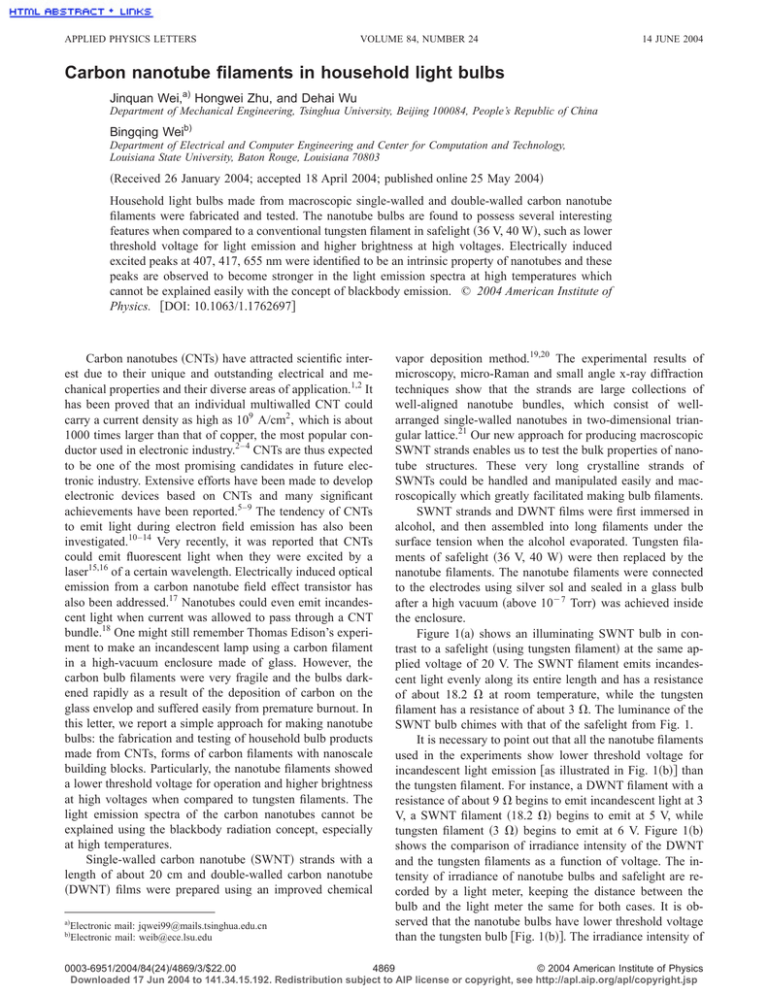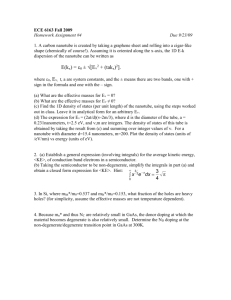Carbon nanotube filaments in household light bulbs
advertisement

APPLIED PHYSICS LETTERS VOLUME 84, NUMBER 24 14 JUNE 2004 Carbon nanotube filaments in household light bulbs Jinquan Wei,a) Hongwei Zhu, and Dehai Wu Department of Mechanical Engineering, Tsinghua University, Beijing 100084, People’s Republic of China Bingqing Weib) Department of Electrical and Computer Engineering and Center for Computation and Technology, Louisiana State University, Baton Rouge, Louisiana 70803 共Received 26 January 2004; accepted 18 April 2004; published online 25 May 2004兲 Household light bulbs made from macroscopic single-walled and double-walled carbon nanotube filaments were fabricated and tested. The nanotube bulbs are found to possess several interesting features when compared to a conventional tungsten filament in safelight 共36 V, 40 W兲, such as lower threshold voltage for light emission and higher brightness at high voltages. Electrically induced excited peaks at 407, 417, 655 nm were identified to be an intrinsic property of nanotubes and these peaks are observed to become stronger in the light emission spectra at high temperatures which cannot be explained easily with the concept of blackbody emission. © 2004 American Institute of Physics. 关DOI: 10.1063/1.1762697兴 Carbon nanotubes 共CNTs兲 have attracted scientific interest due to their unique and outstanding electrical and mechanical properties and their diverse areas of application.1,2 It has been proved that an individual multiwalled CNT could carry a current density as high as 109 A/cm2 , which is about 1000 times larger than that of copper, the most popular conductor used in electronic industry.2– 4 CNTs are thus expected to be one of the most promising candidates in future electronic industry. Extensive efforts have been made to develop electronic devices based on CNTs and many significant achievements have been reported.5–9 The tendency of CNTs to emit light during electron field emission has also been investigated.10–14 Very recently, it was reported that CNTs could emit fluorescent light when they were excited by a laser15,16 of a certain wavelength. Electrically induced optical emission from a carbon nanotube field effect transistor has also been addressed.17 Nanotubes could even emit incandescent light when current was allowed to pass through a CNT bundle.18 One might still remember Thomas Edison’s experiment to make an incandescent lamp using a carbon filament in a high-vacuum enclosure made of glass. However, the carbon bulb filaments were very fragile and the bulbs darkened rapidly as a result of the deposition of carbon on the glass envelop and suffered easily from premature burnout. In this letter, we report a simple approach for making nanotube bulbs: the fabrication and testing of household bulb products made from CNTs, forms of carbon filaments with nanoscale building blocks. Particularly, the nanotube filaments showed a lower threshold voltage for operation and higher brightness at high voltages when compared to tungsten filaments. The light emission spectra of the carbon nanotubes cannot be explained using the blackbody radiation concept, especially at high temperatures. Single-walled carbon nanotube 共SWNT兲 strands with a length of about 20 cm and double-walled carbon nanotube 共DWNT兲 films were prepared using an improved chemical a兲 Electronic mail: jqwei99@mails.tsinghua.edu.cn Electronic mail: weib@ece.lsu.edu b兲 vapor deposition method.19,20 The experimental results of microscopy, micro-Raman and small angle x-ray diffraction techniques show that the strands are large collections of well-aligned nanotube bundles, which consist of wellarranged single-walled nanotubes in two-dimensional triangular lattice.21 Our new approach for producing macroscopic SWNT strands enables us to test the bulk properties of nanotube structures. These very long crystalline strands of SWNTs could be handled and manipulated easily and macroscopically which greatly facilitated making bulb filaments. SWNT strands and DWNT films were first immersed in alcohol, and then assembled into long filaments under the surface tension when the alcohol evaporated. Tungsten filaments of safelight 共36 V, 40 W兲 were then replaced by the nanotube filaments. The nanotube filaments were connected to the electrodes using silver sol and sealed in a glass bulb after a high vacuum 共above 10⫺7 Torr) was achieved inside the enclosure. Figure 1共a兲 shows an illuminating SWNT bulb in contrast to a safelight 共using tungsten filament兲 at the same applied voltage of 20 V. The SWNT filament emits incandescent light evenly along its entire length and has a resistance of about 18.2 ⍀ at room temperature, while the tungsten filament has a resistance of about 3 ⍀. The luminance of the SWNT bulb chimes with that of the safelight from Fig. 1. It is necessary to point out that all the nanotube filaments used in the experiments show lower threshold voltage for incandescent light emission 关as illustrated in Fig. 1共b兲兴 than the tungsten filament. For instance, a DWNT filament with a resistance of about 9 ⍀ begins to emit incandescent light at 3 V, a SWNT filament 共18.2 ⍀兲 begins to emit at 5 V, while tungsten filament 共3 ⍀兲 begins to emit at 6 V. Figure 1共b兲 shows the comparison of irradiance intensity of the DWNT and the tungsten filaments as a function of voltage. The intensity of irradiance of nanotube bulbs and safelight are recorded by a light meter, keeping the distance between the bulb and the light meter the same for both cases. It is observed that the nanotube bulbs have lower threshold voltage than the tungsten bulb 关Fig. 1共b兲兴. The irradiance intensity of 0003-6951/2004/84(24)/4869/3/$22.00 4869 © 2004 American Institute of Physics Downloaded 17 Jun 2004 to 141.34.15.192. Redistribution subject to AIP license or copyright, see http://apl.aip.org/apl/copyright.jsp 4870 Appl. Phys. Lett., Vol. 84, No. 24, 14 June 2004 Wei et al. FIG. 2. Light emission spectra of a DWNT filament at different temperatures. Peaks at 407, 417, and 655 nm can easily be identified and become stronger as the temperature increases. The blackbody radiation spectra at 1350 and 1600 K are drawn for comparison. FIG. 1. 共a兲 A SWNT bulb made from SWNT filament compared with a tungsten bulb operated at same voltage 共20 V兲. The nanotube bulb shows a high brightness and reliability. 共b兲 Irradiance of nanotube filaments as a function of voltage. The DWNT filament 共9 ⍀兲 shows a low onset voltage 共marked arrow兲 for the light emission and emits stronger light than tungsten filament 共3 ⍀兲 at the same voltage. the nanotube bulb increases quickly with increase in voltage. In addition, the irradiance intensity of the nanotube filament is much stronger than that of the tungsten, indicating that the nanotube filaments can emit more visible light than tungsten at the same applied voltage. Light emission spectra of DWNT filaments at different temperatures are plotted in Fig. 2. Temperatures were measured with a pyrometer and compared with the data obtained from curve fitting based on the blackbody radiation. It shows that the emission spectra of the nanotube filaments present a blueshift as the temperature increases. This phenomenon is quite similar to the blackbody emission and the spectra at low temperature (⬍1250 K) can be fitted with blackbody emission. However, at higher temperatures, nanotube filaments emit stronger visible light than the blackbody, based on our experimental results. It is worth mentioning that three peaks at 407, 417, and 655 nm in the visible light region could be identified. These peaks become stronger as electric current increases, indicating an electrically induced light emission property, similar to the fluorescence emission when excited by a laser.15 These same peaks at the same wavelengths could be identified even for a SWNT filament, indicating that the peaks at about 407, 417, and 655 nm in the emission spectra are intrinsic properties of the carbon nano- tubes, which can be triggered by different excitation sources such as light excitation and electric excitation. Two different models10–14 have been proposed to support light emission induced by electron emission from nanotubes, the blackbody radiation due to resistive Joule heating10,13,14 and photon emission caused by electron transitions between different electronic levels.11,12 We found that at 1250 K and below the emission spectra can be explained with the blackbody radiation model, indicating that the light emission from the nanotubes is mainly due to joule heating at low temperatures. However, at high temperatures, the nanotube filament presents electro-luminescence behavior; the peaks appearing at 407, 417, and 655 nm as shown in the spectrum in Fig. 2. The higher the temperature, the higher the intensity of the peaks. In addition, at these high temperatures the emission spectra cannot be explained with the blackbody radiation model anymore. We proposed that the apparent light spectrum emitted from nanotube filaments is a combination of the joule heating and the electro-luminescence effect at high temperatures. We measured I – V curves of the carbon nanotube bulbs using two-probe method 关see Fig. 3共a兲兴. The I – V curves of DWNTs and SWNTs filaments are linear, indicating an ohmic behavior and a constant resistance of the nanotube filaments. However, at high voltages of operation 共e.g., ⬎10 V) the emissive power of the carbon nanotube bulbs is much higher than that of the tungsten bulb, indicating a higher efficiency in electrical power consumption of the nanotube bulbs when compared to the tungsten bulb. The electrical transport properties of carbon nanotubes were evaluated at low as well as elevated temperatures 共less than 300 °C) and both metallic 共electrical resistance increases as temperature increases兲 and semiconducting 共electrical resistance decreases as temperature increases兲 behavior was reported. However, the temperature dependence of the electrical resistance of the nanotube filaments at higher temperatures (⬎1000 K) was measured and was found to show a very different feature 关see Fig. 3共b兲兴. It is surprising that the resistance of nanotube filaments 共both SWNTs and DWNTs兲 remains invariant to changes in temperature in a very large temperature range 共1000–1750 K兲 when com- Downloaded 17 Jun 2004 to 141.34.15.192. Redistribution subject to AIP license or copyright, see http://apl.aip.org/apl/copyright.jsp Wei et al. Appl. Phys. Lett., Vol. 84, No. 24, 14 June 2004 4871 In conclusion, we have fabricated and tested the nanotube bulbs using SWNTs and DWNTs as bulb filaments. The nanotube bulbs have lower threshold voltage and higher brightness at the same voltage when compared to the conventional tungsten safelight. The emitted light spectrum at high temperatures is a combination of blackbody radiation and electro-luminescence. The carbon nanotube filaments which are observed to show invariance to changes in temperature at very high temperatures could be used as resistors in high temperature applications. A household bulb made out of carbon nanotube filaments is expected in the very near future. This work is financially supported by MOST under the State Key Project for Fundamental Research, Grant No. G20000264-04. B.Q.W. acknowledges financial support from LSU Council on Research. 1 FIG. 3. 共a兲 I – V curve comparison of a typical SWNT and a DWNT bulb, as well as a safelight bulb 共36 V, 40 W兲. 共b兲 Temperature dependence of filament resistance at high temperature. The nanotube filaments 共SWNT and DWNT兲 show resistance stability over a large temperature region. pared to a tungsten filament, which shows a typical metallic behavior as expected. It is crucial to understand the mechanism governing this phenomenon and is under investigation. The stable resistance of the nanotubes at high temperatures promises that SWNTs and DWNTs filaments could be used as highly precise resistors at high temperatures. We have also investigated the durability of the nanotube filament bulbs by turning them on and off repeatedly. They worked well even after being turned on and off for more than 5000 times 共7 V, 2.3A兲, showing great stability of SWNT filaments. In addition, the nanotube filament could continuously withstand operation at 25 V (⬃1400 K) for more than 360 h without a visible evaporation. The DWNT filaments however need to be purified in order to remove the amorphous carbon and catalyst content from them before preparing the bulb filaments. This will avoid gradual premature darkening of the bulbs at high temperatures 共above 1300 K兲 due to the evaporation of amorphous and other disordered carbon. M. S. Dresselhaus, G. Dresselhaus, and Ph. Avouris, Carbon Nanotubes: Synthesis, Structure, Properties, and Applications 共Springer, Berlin, 2001兲. 2 R. H. Baughman, A. A. Zakhidov, and W. A. de Heer, Science 297, 787 共2002兲. 3 W. J. Liang, M. Bockrath, D. Bozovic, J. H. Hafner, M. Tinkham, and H. Park, Nature 共London兲 411, 665 共2001兲. 4 B. Q. Wei, R. Vajtai, and P. M. Ajayan, Appl. Phys. Lett. 79, 1172 共2001兲. 5 C. Dekker, Phys. Today 52, 22 共1999兲. 6 A. Bachtold, P. Hadley, T. Nakanishi, and C. Dekker, Science 294, 1317 共2001兲. 7 W. A. de Heer, A. Chatelain, and D. Ugarte, Science 270, 1179 共1995兲. 8 N. de Jonge, Y. Lamy, K. Schoots, and T. H. Oosterkamp, Nature 共London兲 420, 393 共2002兲. 9 B. Q. Wei, R. Vajtai, Y. Jung, J. Ward, R. Zhang, G. Ramanath, and P. M. Ajayan, Nature 共London兲 416, 495 共2002兲. 10 A. G. Rinzler, J. H. Hafner, P. Nikolaev, L. Luo, S. G. Kim, D. Tománek, P. Nordlander, D. T. Colbert, and R. E. Smalley, Science 269, 1550 共1995兲. 11 J. M. Bonard, T. Stöckli, F. Maier, W. A. De Heer, A. Châtelain, J. P. Salvetat, and L. Forró, Phys. Rev. Lett. 81, 1441 共1998兲. 12 L. Forró and C. Schönenberger, in Carbon Nanotubes: Synthesis, Structure, Properties, and Applications, edited by M. S. Dresselhaus, G. Dresselhaus, and Ph. Avouris 共Springer, Berlin, 2001兲. 13 S. T. Purcell, P. Vincent, C. Journet, and V. T. Binh, Phys. Rev. Lett. 88, 105502 共2002兲. 14 M. Sveningsson, M. Jönsson, O. A. Nerushev, F. Rohmund, and E. E. B. Campell, Appl. Phys. Lett. 81, 1095 共2002兲. 15 M. J. O’Connell, S. M. Bachilo, C. B. Huffman, V. C. Moore, M. S. Strano, E. H. Haroz, K. L. Rialon, P. J. Boul, W. H. Noon, C. Kittrell, J. P. Ma, R. H. Hauge, R. B. Weisman, and R. E. Smalley, Science 297, 593 共2002兲. 16 S. M. Bachilo, M. S. Strano, C. Kittrell, R. H. Hauge, R. E. Smalley, and R. B. Weisman, Science 298, 2361 共2002兲. 17 J. A. Misewich, R. Martel, Ph. Avouris, J. C. Tsang, S. Heinze, and J. Tersoff, Science 300, 783 共2003兲. 18 P. Li, K. L. Jiang, M. Liu, Q. Q. Li, S. S. Fan, and J. L. Sun, Appl. Phys. Lett. 82, 1763 共2003兲. 19 H. W. Zhu, C. L. Xu, D. H. Wu, B. Q. Wei, R. Vajtai, and P. M. Ajayan, Science 296, 884 共2002兲. 20 J. Q. Wei, L. J. Ci, B. Jiang, Y. H. Li, X. F. Zhang, H. W. Zhu, C. L. Xu, and D. H. Wu, J. Mater. Chem. 13, 1340 共2003兲. 21 B. Q. Wei, R. Vajtai, Y. Y. Choi, P. M. Ajayan, H. W. Zhu, C. L. Xu, and D. H. Wu, Nano Lett. 2, 1105 共2002兲. Downloaded 17 Jun 2004 to 141.34.15.192. Redistribution subject to AIP license or copyright, see http://apl.aip.org/apl/copyright.jsp






